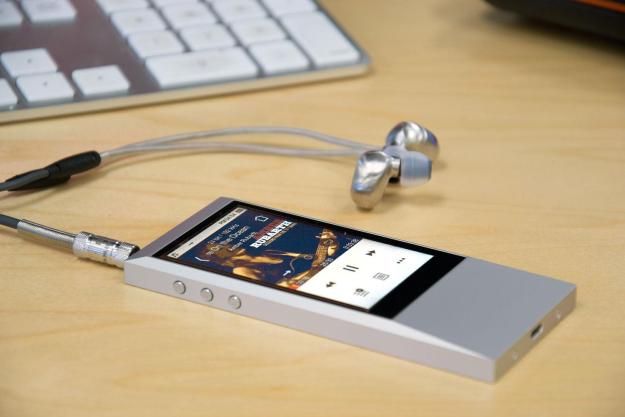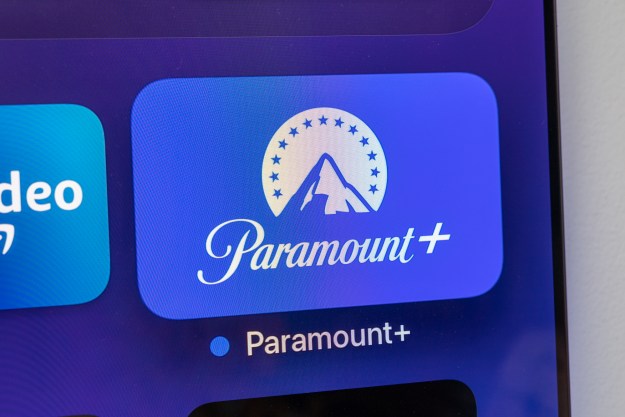
“With a sleek and compact design, plenty of features, and smartphone-crushing sound, Astell & Kern’s AK Jr emerges as the portable hi-res player to beat.”
- Sleek and highly portable design
- Rich, clear, and powerful sound
- Strikingly expansive, dimensional sound stage
- Ample storage
- Excellent value for the genre
- Battery life could be better
- Wish for Wi-Fi
High-end portable audio maker Astell & Kern has never shied away from its core demographic, taking pride in making plush audiophile gear for the top 1 percent of music listeners. The company’s flagship player sells for a staggering $3,500, but someone in the front offices must’ve put in a good word for the little guy, resulting in the line’s most affordable piece of hi-fi gear yet: Say hello to the slim and sleek AK Jr., priced at a cool $500.
Certainly, $500 is no pittance, even when you’re talking about something as luxurious as a dedicated high-resolution portable music player. But spending just a few minutes with this silver slab of audiophile goodness will be enough to convince any serious hi-fi listener that the AK Jr. is not kidding around. In fact, when it comes to sheer value, this device is in strong contention for best-in-class in the portable hi-fi market.
Out of the box
The AK Jr.’s aesthetic offers shades of the opulent AK240, boasting the same matte aluminum body drawn in sharp angles. On the back is a textured panel glittering beneath a sleek sheet of glass. However, with its minimalist exterior and exquisitely thin frame (measuring 6.9mm at its slimmest point, and 8.9 mm at the top), the Jr is, in many ways, more appealing as a portable than its predecessors, minimally crafted to look and feel more like a piece of Cupertino currency than any previous AK installment.
The feather-light frame weighs in at just 3.28 ounces, and measures 4.5-inches long by 2-inches across, making it smaller than an iPhone 5 and exceedingly easy to slip into your pocket — something Neil Young’s infamous Pono Player simply can’t claim. And really, we can’t stress the size factor enough — as the least imposing portable hi-fi player we’ve encountered, the AK Jr. makes it easy to take along brilliant sound virtually anywhere. AK calls it a concert in a box, and for once, we’d say that PR jargon is dead on — but we’ll get to the sound performance later.
Features and design
Controlling the AK Jr. is handled through a score of touch screen commands, supplemented with physical controls in the form of buttons at the left side for song search and pause/play, as well as the same tactile volume dial set in aluminum you’ll find on board all AK portables. While it looks a little old fashioned, the dial offers brilliantly-exact volume adjustment.
The AK Jr.. seems like an Apple product that’s been overhauled by an audiophile mad scientist.
The 3.1-inch touchscreen interface controls an adapted version of Android — and though it’s likely slower than your shiny new smartphone, it’s snappy enough to get the job done, and relatively intuitive after some exploration. The main screen is self-explanatory, allowing browsing by artist, genre, playlist, etc. And tracking down the settings icon at the top right opens an ample selection of deeper options, including display brightness, power, lock, and Auto Library scan (which checks for new music upon power-up). Tapping the home button returns you to the main screen.
A quick tap on the triple dots at the bottom calls up song info so you can investigate file data, create a playlist, or engage a five-band EQ, though we preferred to simply let the player do its thing. At the bottom center is a key for song lyrics, and the key at the far left takes you back to the library to call up new tracks on the fly.
The player offers a single headphone out at 1.95 Vrms with 2-Ohm output impedance. There’s no balanced line-out, but the device does have a workaround via a fixed max-volume function in the settings. Bluetooth wireless connection is available for those so inclined, but the lack of Wi-Fi support means you’ll have to go old school for settings like time and date, and all music purchases must be done via a PC or Mac. But really, that was never a hindrance during our evaluation — that’s what we have smartphones for. Battery life lasts around 6-8 hours, and the device can also double as a USB DAC (digital audio converter) to bypass your computer’s sound card.
Under the hood, the AK Jr. boasts the same Wolfson WM8740 DAC as the original AK100, a top-quality stalwart in the hi-fi world. Audio resolution tops out at 24bit/192kHz, and the player can handle virtually any audio file, including WAV, FLAC, OGG, ALAC, and single-rate DSD files at 2.8MHz (though they’re converted to PCM). There’s 64GB of native storage, and a microSD slot for an additional 64GB of storage to accommodate those massive high-resolution audio files.
Audio performance
And now for the fun part: For those who’ve yet to explore the joys of high-resolution audio players, the easiest way to describe the sound of the AK Jr. is like opening a window and floating softly into a live performance. All electronic noise and interruptions are essentially eliminated, creating a clear open space in which your favorite hi-res tracks are free to flutter effortlessly to and fro, expanding across an enormous, dimensional soundstage.
Paired with our trusty Audeze EL-8, the AK Jr. offered a dangerously alluring level of sonic prowess. Bass is rich, ruddy, and bellowing, yet utterly organic. It’s the kind of full and powerful sound that today’s bass-centric headphones try to emulate, but end up only serving up a failure of a bloated, overbearing imitation. Above, midrange audio is clear and vibrant, and the upper register is lyrical and spritely — almost to a fault on lighter tracks, but we aren’t complaining.
The AK Jr.’s soundstage is massive — seeming to spill out of the left and right channels in a bowed extension that burrows into the very tips of the earpieces. Instruments enter and exit the buoyant dimensions in a long, subtle approach that allows for exploration of every nuance at the attack and decay of each note. Front-to-back dimension is equally expansive, allowing for multiple layers of instruments to push back into the ether, or saunter into the front row.
A particular moment in our evaluation that put all that space on display came from Cassandra Wilson’s Another Country, which spills a multitude of percussion elements exposed in a deep vivisection of layered wood blocks, shakers, and various elemental wood instruments. There was a moment in which the upper register effects were just a tad too spritely at the top, but the warm breadth of the lower register instruments below added a balancing complement.
Apart from the space, the AK Jr. draws details brilliantly, from richly cut guitar tones exposed in stacked layers of grit and gloss, to the crunchy squeak of a saxophone reed so close you can almost feel the air on your skin. Our exploration of Alexis Cole’s Ain’t We Got Fun, served up the dreamy sax solo in the right channel with a vivid clickity clack of keystrokes that may as well have been live.
In comparison to other players in the industry, the AK Jr. offers sound quality at least on par, if not better than Young’s Pono Player — especially when it comes to sheer stereo expansion. As for the the AK240 we reviewed last year, the Jr doesn’t offer quite the same level of Fantastic Voyage-style textural dimension — there’s simply less to explore there, as if instrumental textures are slightly dulled down. Still, the difference between the two players is much slighter than the price points suggest, and will likely go unnoticed by all but the most seasoned audiophiles and dedicated listeners, and through top-flight gear at that.
The DT Accessory Pack
Up your game and the get the most out of your gear with the following extras, hand-picked by our editors:
Audeze headphones
Shure 1540 headphones
Cable Matters 3.5mm to RCA cable
Conclusion
We wrote in our AK240 review that few people can really justify its exorbitant cost, making it all but prohibitive for most listeners. But that tall spire of inaccessibility has moved enticingly within arm’s length thanks to the AK Jr.. Offering a gorgeous design that’s brilliantly compact, plenty of features, and sound that absolutely crushes your pitiful smartphone, the AK Jr. emerges as the frontrunner for those looking for audiophile sound they can slip into their pocket.
Highs
- Sleek and highly portable design
- Rich, clear, and powerful sound
- Strikingly expansive, dimensional sound stage
- Ample storage
- Excellent value for the genre
Lows
- Battery life could be better
- Wish for Wi-Fi
Available at: Amazon
Editors' Recommendations
- Astell&Kern’s latest mobile DAC gets dual outputs, AKM chip
- Astell&Kern refreshes its UW100 wireless earbuds
- Miss the iPod? Astell and Kern has the cure — for a price
- Astell&Kern blurs the line between headphone amp and digital audio player
- How to play FLAC files on all of your iOS devices for the best lossless sound









